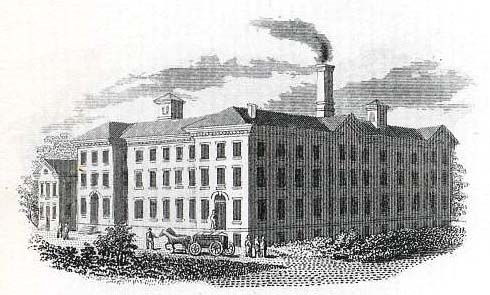The Gibsonton Mills Distillery
RD #14, 23 rd District
Westmoreland County, PA
(Est. 1856)

distillery search | pre-pro.com home
The Gibsonton Mills Distillery |  |
The Gibsonton Mills distillery was built in 1856 on 40 acres of land on the east side of the Monongahela River, just to the south of Pittsburgh. Reports of the time note that it was built of limestone from a nearby quarry. Gibson died in 1865 and the business passed to his son, Henry Clay Gibson. Henry formed an association with Andrew M Moore and Joseph F Sinnott and the company now ran as John Gibson's Son & Co. In 1870, Ernest Hexamer undertook the first of a series of surveys of the facility, mapping the buildings and noting many details of its operation. Hexamer was an insurance surveyor based in Philadelphia: his records are available online at www.philadelphiahistory.org. His first survey can be found at http://www.philageohistory.org/rdic-images/view-image.cfm/HGSv5.0364-365. When Hexamer surveyed the property in 1880, he noted that the plant employed 55 men and three boys. He also notes that Warehouse No. 4 (a Free Warehouse) had been completed in 1870 and No. 5 (stone, one-story plus basement, iron roof) had been completed the year of the survey. Another (No. 6) was under construction (two story plus basement, stone, iron roof), but the plans show another bonded warehouse (No. 7: stone with a slate roof) and a warehouse labelled No. 8. It was frame, one-story, with a board roof. In December 1882, a fire in warehouse No. 1 destroyed 3,000 barrels of whiskey. Another fire was started six months later (June 21, 1883) when a barrel popped its bung and spread whiskey over a lamp carried by worker Henry Neil. The resulting fire quickly engulfed Warehouse #2 and then adjoining warehouse #3, with a loss of 10,000 barrels worth $500,000 (reported in the New York Times). Hexamer conducted his survey on September 24 of that year and his plan notes that there was an embankment where Warehouses 3 and 4 once stood. He notes that the distillery had been rebuilt during 1883, and that warehouse No. 7 had been put up in 1882. The published plans appear to be a copy of the 1880 survey. Warehouse No. 4 has a strike-through that changes it from a Free to Bonded warehouse. Warehouse No. 8 has been divided into two, creating a new warehouse No. 10. The plans also show a warehouse No. 9 (one story frame with an iron roof). Henry Gibson retired from the liquor business in 1883, leaving Moore and Sinnott at the helm. Hexamer next surveyed the plant in 1887. He found that Bonded warehouse No. 2 had been rebuilt of stone and stood at the site of previous Nos. 2/3. It was again four-story plus a basement. Bonded warehouse No. 8 had become part of Free warehouse No. 10. There were two new warehouses. No. 11 was undesignated, one-story frame with a gravel roof. No. 12 was a Free warehouse, one-story iron-clad with an iron roof. By 1890, the plant had expanded to the point where Hexamer need two full two-page spreads to describe it adequately (see floor plans, details and structures). Bonded warehouse No. 2 had been split to recreate Nos. 2 and 3. There was a new Bonded warehouse No. 8, built of brick with a gravel roof. It was four stories high. Warehouse No. 11 was now bonded and No. 13, another bonded warehouse (one story, gravel roof) had been built alongside. The 1892 survey revealed yet further expansion (see floor plans, details and structures). Hexamer notes that the plant had a capacity of 1250 bushels and employed 100 men, 6 boys. A large new Bonded warehouse had been added (Warehouse "A", 5 story brick, with a gravel roof) and there was a new Free warehouse (Warehouse "B", one-story frame with a granite composition roof). The final survey was conducted in 1895 (see floor plans, details and structures). Hexamer again notes that the plant had a capacity of 1250 bushels and employed 100 men, 6 boys. Three new Free warehouses had been built, all one-story frame with asbestos roofs - "C", "E" and "E". (Warehouse "E" had a felt roof). All the lettered warehouses and Bonded warehouses 5 and 6 had been ditched so as to direct burning whiskey toward the railrod and away from the distillery in the event of fire. The fate of Moore is uncertain, but Joseph F Sinnott apparently died in 1906. The company was reorganized as the Gibson Distilling Co. Inc. in 1908 or 1909. The Gibsonton distillery ceased operations in 1919 when Prohibition dawned, but the extensive stocks held in the bonded warehouses were sold off for medicinal use for many years later. The distillery site was eventually acquired by Pittsburgh steel, who in 1926 dismantled the limestone buildings and sold off the blocks for $1 a load. |

Internal Revenue recorded warehouse transactions for The Gibsonton Mills Distillery as follows:
( explain: origin of these records, letter codes )
Copyright © 2006-2025 www.pre-pro.com. All rights reserved.